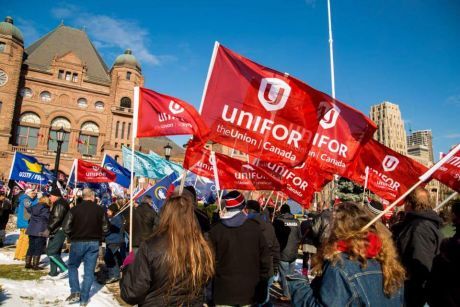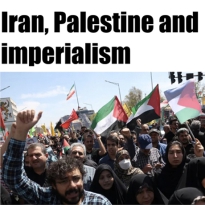Shared
You are here
Unifor-CLC split demands unity from below

January 18, 2018
“We hadn’t set up a new organization in order to be cannibals in the Canadian labour movement.” — Bob White, first president of the Canadian Auto Workers (now Unifor).
Unifor, Canada’s largest private sector union, has left the Canadian Labour Congress (CLC). Unifor’s website says the decision was made by its National Executive Board on January 16. In a letter to CLC President Hassan Yussuff dated January 17, Unifor President Jerry Dias states that Unifor’s Executive Board has voted to cease affiliation to the CLC “immediately.”
This will have reverberations across the entire labour movement, and the Unifor membership has had no say in the decision
Unifor’s grievances
In his January 17 letter to Yussuff, Dias provides two main reasons for their decision to withdraw. First, Dias states that Article 4 of the CLC Constitution — which was designed to govern disputes between unions — is being misapplied. This is framed in terms of democratic rights of union members to choose their own unions. He says unions affiliated to CLC frustrate this process, and furthermore that Unifor was excluded from having representation on a CLC advisory committee on Article 4.
Second, Dias states that the CLC has not upheld Article 26 of the CLC constitution defending the autonomy of Canadian unions in the face of international union leaderships based out of the United States.
Behind the grievances
The subtext of the split is Unifor’s involvement in the internal crises of other unions, and an ongoing dispute over the political direction of the labour movement.
The 2017 crisis that embroiled the Amalgamated Transit Union local 113, representing 10,000 Toronto Transit Commission workers, was a major sign that all was not well in the house of labour.
In February 2017 the ATU International trusteed Local 113 after learning its president, Bob Kinnear, sent a letter to the CLC requesting access to section for 4.9 of the CLC constitution. This outlines the process for justifying changing unions. Kinnear did this without any membership or executive board involvement.
Documents and recordings that RankandFile.ca unearthed made it clear that Unifor was colluding with Kinnear in this process. They paid Kinnear’s legal fees and communicated with him prior to the trusteeship. Other executive board members were even recorded accurately outlining the sequence of events before they unfolded and confirming Unifor’s prior involvement.
As Unifor’s involvement became known, Local 113’s executive board, shop stewards, and membership turned on Kinnear. Kinnear eventually resigned. The CLC’s investigation into the events was cut short at this point. The crisis at ATU Local 113 smacked of an attempted raid. Both Unifor’s actions and the CLC’s preliminary report were roundly criticized by other affiliate unions.
RankandFile.ca has also learned that Unifor is now involved in the crisis at UNITE HERE Local 75, a Toronto-based union of 8,000 hotel, restaurant and food service workers. UNITE HERE Local 75’s leadership, carrying the majority of its members, though not a majority of its executive board, is fighting a trusteeship imposed on it by UNITE HERE International (UHI). This is a long and complex story with more details yet to emerge, but what is key to understand now in relation to the CLC disaffiliation is that Unifor is now actively involved in the dispute. Unifor is signing cards of Local 75 members and a section of its leadership resisting trusteeship is now supporting Unifor.
As Dias’s letter suggests, Unifor will frame this, as it did with the ATU crisis, along nationalistic lines.
A history of division at the top
None of these divisions are new. From 2000 to 2001, the Canadian Auto Workers (CAW) were out of the CLC after raiding the Service Employees International Union. This meant CAW was excluded from provincial federations and labour councils everywhere but in Quebec. CAW merged with CEP in 2013 to form Unifor.
In the 2014 CLC election, CLC president Ken Georgetti was the first ever incumbent to be defeated. The hotly-contested election was decided by a handful of votes with Unifor backing Hassan Yussuff and many other major affiliates backing Georgetti. At the CLC convention last year, all of the candidates supported by Unifor were elected, leading Jerry Dias to tweet a photo of himself holding a broom saying it was another clean sweep at the CLC for Unifor.
At the 2017 Ontario Federation of Labour convention there was a motion from the floor for the OFL to offer partisan support for the NDP. This evoked a heated debate which pitted Unifor delegates, whose old CAW side has backed strategic voting since the late 1990s, against delegates from most other unions. The pro-NDP motion was passed and it was clear the leadership of Unifor was not pleased.
The Fallout
The divisions at the top are not new, but splits have a real effect on the ground.
Consider the timing of this split as Tim Hortons owners have sparked off an explosion of working-class anger against employers we haven’t seen in years. There is a national discussion over working conditions and organizing the unorganized. This demands a coordinated, united and strategic response from all unions.
On the ground, union activists get this. Unifor members were right at the centre of organizing the Cobourg Tim Hortons protest in collaboration with many other union members in Durham Region Labour Council and Northumberland Labour Council. This was a fine example of the unity we need at the local level to wage real fights against the bosses.
Unifor’s insistence on a split is a waste of resources that could be directed into political and union organizing instead. Roughly $10 million in dues going to the CLC, provincial federations, and labour councils will be lost. This will lead to staff layoffs and weaker campaigning capacities from federations and labour councils across the country.
In Ontario when OPSEU left the OFL in 2011, OPSEU and CUPE started and worked on two separate campaigns to stop Hydro privatization, rather than work together. When an Ontario Liberal convention was being held in Toronto in the wake of the horrendous Bill 115 assault on teachers bargaining rights, OPSEU and the OFL held two separate rallies. These sort of divisions are but a taste of what negative impacts a divided labour movement can present.
A very likely consequence is opening the door to much more raiding. Unifor will no doubt direct resources to raiding already unionized workers, rather than focusing on organizing the unorganized. This will also sap the organizing resources of unions trying to fend off the raids.
This split will is likely to re-open old wounds. The SEIU-UNITE HERE-Workers United saga which racked the US labour movement in 2009 and spilled over into Canada, may come roaring back with Unifor’s intervention in UNITE HERE Local 75. The ATU-Unifor fight from 2017 is also likely to start anew, and many other past conflicts involving the CAW/Unifor could be reignited.
Unlike the brief NUPGE disaffiliation in 2010, the amount of existing bad blood does not bode well for a quick fix.
Our unions put precious few resources into organizing. There is a battle that needs to be waged to change this. But if unions are at each other’s throats in raiding wars, workers are going to lose and employers are going to win.
Nationalism and democracy
While Unifor’s recent efforts in the NAFTA renegotiations to fight for Mexican workers’ rights and reach out to them is good labour internationalism and should be applauded, its approach to international unions operating in Canada is far less progressive.
Dias has repeatedly called for Canadians to have democratic control of their unions against the control of American union leaders. We heard this during the ATU Local 113 trusteeship.
But there was never anything democratic about Kinnear’s initiation of the justification process to change unions, or Unifor’s involvement. Nor is Unifor’s internal democracy something to write home about. Members with different views inside Unifor are regularly frozen out of all sorts of union bodies and activities. This isn’t a problem limited to Unifor.
Canadian unions need to be controlled democratically by their members. This doesn’t just mean opposing American union leaders who trample democracy, but Canadian union leaders who do the same.
There is a real danger that Unifor will play up the nationalism card as it attempts to sell this split to its members and win other unions. This is extremely dangerous and harmful when we need more cross-border solidarity, not less. The immanent right-to-work assault in the U.S. (via the Janus v. AFSCME case) and the rise of far-right nationalism and racism means the union movement should be aiming to stand up as a united front across the continent.
Our priorities: Building unity from below
So where should our focus be? Palace intrigue at the top, or focusing on building a fighting working class movement from below? We think the latter.
Trade unionists across Canada should be coming together to build the January 19 National Day of Action in support of Tim Hortons workers. At the same time we need to reject this division being imposed on us from above.
The split and its possible consequences are a propaganda gift to employers. If Unifor does in fact begin raids, it allows business to spin more stories about greedy unions who only care about union dues.
Though Unifor says it will continue its membership in provincial federations and local labour councils, the CLC constitution and practice is clear: disaffiliation from the CLC means the disaffiliation from provincial and labour councils.
At the local level, it will be important that Unifor activists engaged in work with other union members are not ostracised because of the decisions of their union leadership. Activists pushing for unity at the local level will be absolutely necessary if the labour movement wants to fight and win. While there is disorder at the top, keeping a fighting labour movement will require unity from below.
This crisis is not going to be solved by backroom deals or bureaucratic maneuvering at the top. We have to reject the temptation of union factionalism and focus on building the power of our movement from below. Union members must hold their leaders to account to help solve this impasse and get back to fighting for the interests of workers.
There’s a huge opening across the country to advance a $15 minimum wage and organize the most unorganized sectors. The alternative is a divided labour movement that can be easily conquered by the bosses and hostile governments.
This is shared from rankandfile.ca
Section:










